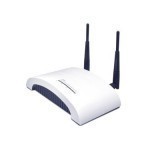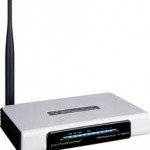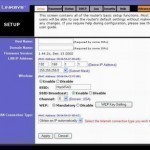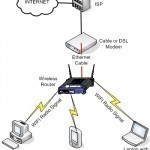Multicast is the transfer of messages to multiple destinations simultaneously, using fewer networks. The information is delivered to each of the links only once, and copies are created when the links to the destinations split, thus creating an optimal distribution path. Multicasting reduces unnecessary packet duplication. A wireless network utilizes radio communication, unlike wired networks, which employ electrical conductors. Wireless multicasting can therefore be loosely defined as the process of multicasting over wireless networks. Multicast over wireless networks is a fundamental communication function as well as a challenging goal. The Read More
Range Extender

A range extender is a device that can be placed between two connection points in order to bounce a wireless signal from one device to another. Range extenders work great for large offices and factories that need high-speed Internet throughout the premises without running cables or purchasing satellite Internet. Range extenders can be used with virtually any router or access point and various models offer different features. In order to compare products, we will list several range extenders that are available on the market. Belkin Wireless G Universal Range Extender Read More
WRAP (Wireless Robust Authenticated Protocol)

WRAP (Wireless Robust Authenticated Protocol) is an encryption protocol in the 802.11i standard. WRAP is based upon the Offset Codebook (OCB) mode of AES. WRAP is being Replaced with CCMP Intellectual property rights issues have plagued WRAP. Three different parties have filed for patents on WRAP. These intellectual property issues caused the IEEE to introduce CCMP into the 802.11i standard and make WRAP an optional component of RSN (Robust Secure Network).
SMS (Short Messaging Service)
SMS, or Short Messaging Service, is a text-based messaging service that is used by over 2.4 billion mobile phone users worldwide. SMS allows users to send and receive text-based messages, pictures, videos, and audio clips from other mobile phone users and desktop computer users who have applications that can interact with mobile phones. SMS differs from emails and other text-based communication methods because it is compliant with 3G and 4G networks and has a maximum limit of 240 characters per page, making it ideal for short messages. How SMS Read More
LMDS (Local Multipoint Distribution Service)
LMDS (Local Multipoint Distribution Service) is a broadband wireless point-to-multipoint specification utilizing microwave communications. LMDS operates on FCC licensed frequencies. The FCC divided the United States into 493 BTA's (Basic Trading Areas) and auctioned the rights to transmit on the LMDS bands in each of those areas to LMDS service providers. Each BTA is licensed to two LMDS service providers. The LMDS bandplan is available from the FCC at http://wireless.fcc.gov/auctions/data/bandplans/lmds.pdf. LMDS Specifications Fixed/Mobile Fixed Circuit/Packet: n/a Max Bandwidth 1.5Gb downstream, 200Mb upstream Range 4 miles Frequency 27.5GHz-28.35Ghz, 29.1Ghz-29.25Ghz, 31.075Ghz-31.225Ghz, 31.Ghz-31.075Ghz, Read More
802.11b
802.11b is the standard that is popularly used for high speed wireless networks. The standard is set by IEEE (Institute of Electrical and Electronics Engineers) and uses a 2.4 gigahertz radio frequency. There are several standards that are in use today for wireless communication from one computer device to another; however 802.11b is cost effective, quick and easy to use. For many people, building a wifi network is easier than ever thanks to 802.11b. This technology usually includes a wireless router that is able to send radio signals using 802.11b Read More
SSID (Service Set IDentifier)

The SSID (Service Set IDentifier) is a token that identifies a 802.11 (Wi-Fi) network. The SSID is a key that the wireless network administrator sets. Users must know the SSID to connect to an 802.11 wireless network. However, network sniffing/scanning allows users to determine the SSID. By default, the SSID is part of the packet header for every packet sent over the WLAN. SSID access points continuously broadcast radio signals that enabled client machines receive. Based on the automatic or manual configuration, the client can connect to the access point. Read More
CDMA-2000 1xRTT
CDMA-2000 1xRTT is a 3G wireless technology based on the CDMA platform. The 1x in 1xRTT refers to 1x the number of 1.25MHz channels. The RTT in 1xRTT stands for Radio Transmission Technology. The CDMA-2000 1xRTT protocol was developed by Qualcomm. CDMA-2000 1xRTT is a CDMA version of the IMT-2000 standard which was developed by the International Telecommunication Union (ITU). Verizon and Sprint both operate CDMA-2000 1xRTT services in the United States. CDMA-2000 1xRTT Specifications Fixed/Mobile Mobile Circuit/Packet Packet Max Bandwidth 144Kb Range Coverage area of host network Frequency Frequency Read More
How to Setup a Wireless Network

For those who have been contemplating setting up a wireless network in their home, there are many reasons to consider how a wireless network will benefit you. One reason that many people decide to set up a wireless network is to share a internet connection. By setting up a wireless network, several family members can be on the Internet at the same time. As well, the use of a wireless network also make it possible to send files between different computers without having to save the information to a diskette Read More
How to Connect to WiFi
Wi-Fi is a registered trademark for products that adhere to IEEE 802.11 standards. These products are certified by the Wi-Fi alliance and the Wi-Fi trademark is owned by them. The certification indicates that wireless devices can recognize and communicate with each other irrespective of their manufacturer. The Wi-Fi alliance is basically a syndicate of individual companies that work together to provide wireless products based on the same IEEE 802.11 standards. They provide certification for products based on a series of test events. If a product passes these tests, their manufacturer Read More


Share on: